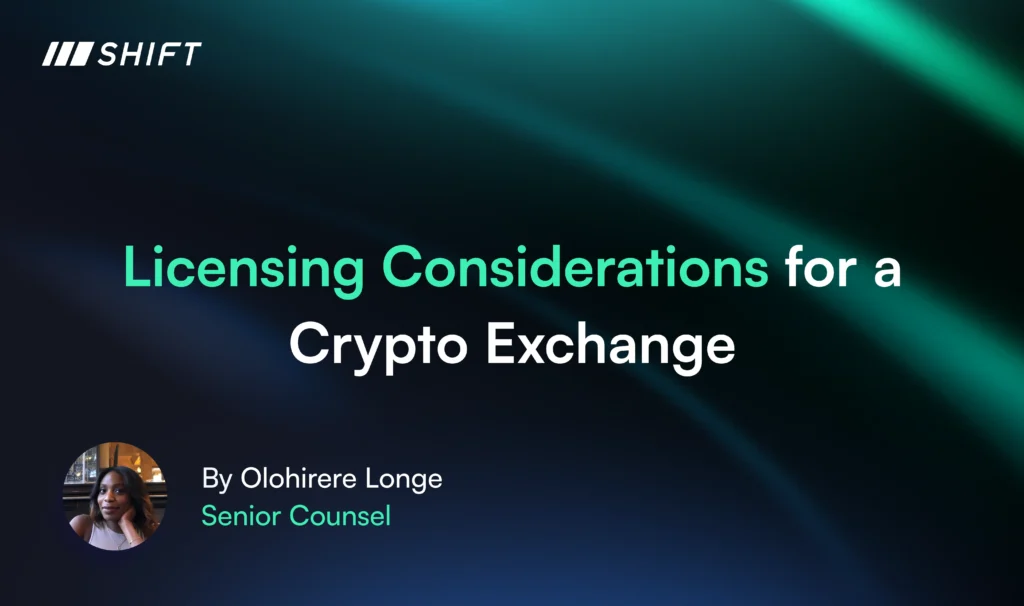Summarize with AI:
Written by Olohirere Longe, Senior Counsel
Introduction to Global Crypto Regulations
As digital assets continue to gain adoption, some of the regulatory expectations and frameworks are getting clearer.. Sustainable themes include a commitment to user protection, financial integrity, and long-term sustainability.
While regulations vary by jurisdiction, the common thread is clear: frameworks focus on financial stability, market integrity and transparent communications with regulators. These overarching concepts are key to start the licensing process in a new jurisdiction.
Crypto regulation varies significantly across regions, from clearly codified expectations for licensees as seen in the EU, to ongoing industry consultation and a roadmap for regulations in the UK, to more suggestions for alignment with traditional financial markets as seen in the US. In the United States, regulatory oversight is fragmented. The MSB license, issued by the FinCEN, provides federal recognition to operate as a Money Service Business. However, this doesn’t automatically grant state-level permissions. Each state has its regulations, and while some honor the federal license, many require individual state licenses. We offer guidance tailored to both federal and state-specific regulations, ensuring comprehensive coverage. Crypto exchanges are in most instances considered to be money transmitters for this purpose. The Securities Exchange Commission (SEC) oversees assets considered to be securities and the Commodity Futures Trading Commission (CFTC) also has some oversight on digital asset commodities. A patchwork approach is taken in the US.
In contrast, the European Union has introduced a unified approach with the Markets in Crypto-Assets (MiCA) regulation. The purpose of MiCA is to bridge gaps in existing EU financial services legislation by establishing a harmonized set of rules for crypto-assets and related activities and services. To offer crypto services in the EU, registration as a Crypto-Asset Service Provider (CASP) is required as part of its AML/CTF Crypto Registration process. In addition, required businesses should also obtain authorization with the competent authority they are established in.
The United Kingdom is moving from a light touch regime – registering with the Financial Conduct Authority (FCA) for AML. To getting a full blown financial services license and the activities will be clearly defined. There will be new regulatory obligations and new supervisor duties.i. There aren’t currently any regulations on stablecoins in the UK. Right now just e-money which is an account based product. Issuing a stablecoin is a new regulated aspect. Thankfully, a regulatory roadmap has been issued and we expect policy statements to be published by 2026.
In the UAE In addition to UAE federal law, each emirate has its own laws and regulations in areas where there is no federal law.. Of note is VARA. The Dubai Virtual Assets Regulatory Authority is the only regulatory authority in the UAE that exclusively regulates virtual assets. It was established and authorised in 2022 to regulate virtual asset service providers (VASPs). VARA applies to the Virtual Asset services provided in all zones across Dubai, including Special Development Zones and free zones. In the Asia-Pacific region, countries like Singapore and Hong Kong have established defined licensing frameworks through MAS and the SFC, respectively. These frameworks emphasize AML compliance, risk management, and transaction monitoring. Australia’s AUSTRAC and ASIC also play active roles in enforcing similar standards.
Core Areas of Compliance Focus
Understanding and meeting regional compliance expectations is essential for exchanges looking to scale across borders. Here are the core things to know: build flexible systems for KYC/KYT and AML, tailor tools to each jurisdiction, and engage local counsel early to reduce risk and speed up approvals.
Operating a crypto exchange within a regulated environment requires embedding strong compliance measures across multiple domains. Anti-money laundering and counter-terrorism financing controls must be built into the core technology stack. These include customer due diligence, continuous monitoring, suspicious activity reporting, and comprehensive audit trails. Licensing is another cornerstone, with operators typically required to register or gain authorization before launching. This process involves submitting governance structures, business models, and proof of qualified leadership.
Leadership and operational oversight are also critical. Many jurisdictions require the appointment of a Compliance Officer or Money Laundering Reporting Officer, and often expect senior executives to be physically located within the region of regulation. Working with external vendors introduces additional considerations. Third-party providers for custody, payments, or compliance solutions must be vetted, and in some cases, subject to audits or contractual oversight. Legal and tax considerations also play a key role. Structuring your entity to align with local tax obligations and regulatory norms helps ensure long-term viability.
Some jurisdictions offer regulatory sandboxes, which allow firms to test products and services under supervisory conditions. Participating in these programs can accelerate regulatory feedback cycles, lower risk during launch, and build trust with authorities from the outset.
Current Trends in International Regulations
Regional Perspectives and Differences
Regulatory approaches to crypto vary widely across regions. In the U.S., the focus remains on enforcement and investor protection. Europe is pursuing a more unified regulatory framework through MiCA, which sets consistent rules for crypto asset service providers across member states. Meanwhile, markets like Singapore and the UAE are fostering innovation through structured licensing regimes that balance oversight with growth.
For platforms operating in multiple jurisdictions, these differences can pose challenges, but also offer a roadmap. Understanding how local rules shape operations helps teams decide where to launch, how to structure their services, and what compliance strategies to adopt. In nearly every case, AML/CFT requirements are typically the starting point.
How to Navigate Cross-Border Compliance
Launching or scaling across borders means managing cross-jurisdictional regulatory obligations. The key is building a flexible, adaptable compliance framework from day one. Modular systems, such as customizable KYC flows and KYT integrations, help exchanges tailor their processes to each jurisdiction’s requirements.
Expanding a crypto exchange across borders requires navigating overlapping and sometimes conflicting regulatory requirements. It is worth prioritising compliance frameworks that are specially suited to the region and service offering. Modular systems, such as customizable KYC workflows and KYT integrations, allow exchanges to adjust their operations to meet jurisdiction-specific rules efficiently. Coupling automated AML and CFT processes with manual review help due diligence, transaction monitoring, and blockchain analytics helps strengthen compliance while maintaining scalability. These tools should integrate with the broader tech stack and provide clear visibility to compliance teams.
Equally important is managing third-party risk. Collaborating with vetted service providers for custody, payments, and compliance tooling is essential, and exchanges must be ready to audit these partners to confirm they meet local standards. Strong governance is another core pillar. Jurisdictions typically require local senior management and a designated Compliance Officer or MLRO, along with well-documented frameworks for oversight, escalation, and outsourced functions. Finally, registration or licensing is generally mandatory before operations can begin. Where available, regulatory sandboxes offer a strategic advantage, allowing exchanges to test products under supervision, gain early feedback, and improve their odds of regulatory approval.
The Legal Shortcuts That Cost Exchanges Everything
Tailor your KYC, reporting, and audit systems to each jurisdiction from the start. Hire experienced, region-based officers with real authority. Overreliance on third-party vendors without proper oversight is another common mistake. Vet them, audit them, and keep documentation ready. Tax issues often come last, but poor entity structuring can trigger double taxation or licensing problems.
The Future of Cryptocurrency Regulation
The future of global crypto adoption hinges on the emergence of clearer regulatory standards. Clear and predictable rules also lay the groundwork for deeper institutional involvement.Key developments to watch include the GENIUS Act in the U.S., which introduces stablecoin-specific rules, and the UK’s cryptoasset roadmap, expected by 2026, which will broaden oversight beyond AML and CTF.
Closing Thoughts
Building a successful crypto exchange today requires more than just a strong product, it requires a strong regulatory foundation. Licensing, AML protocols, governance, and oversight are the infrastructure that enables credibility, trust, and sustainable growth. Teams should approach regulation as an integrated part of their market strategy.
If you’re planning to launch or expand, get in touch and we’ll help you build with compliance at the core.
Share this article:
Want to learn more?
Let us save you time by walking you through what Shift can do for your business!



